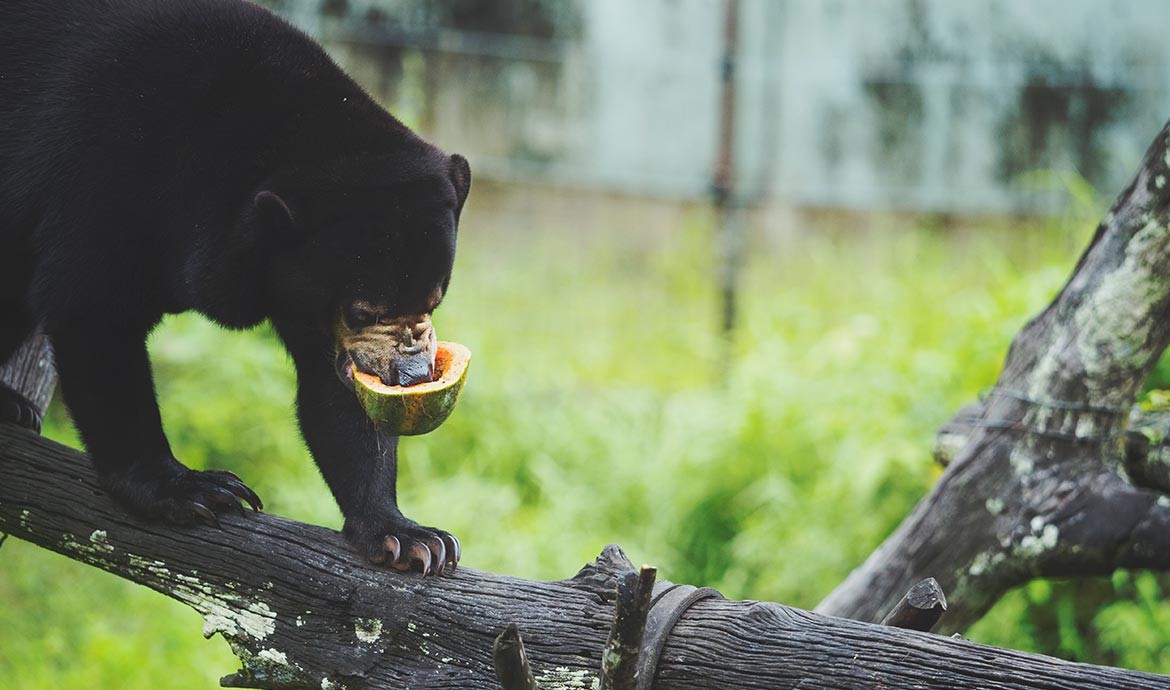When we are talking about bear, most of us would think about polar bear with its distinctive white fur, or grizzly bear that’s famous for its ferocity.
But do you know that there’s a species of bear that is native to Southeast Asia called the sun bear? For a second, let’s put aside the famous bears and focus on this adorable one instead.
The Smallest Bear Species in the World

The sun bear stands out among its bear cousins for various reasons, but the biggest one is, ironically, its small size. Even the adults would weigh less than a big dog and this is why in Thailand, the sun bear is called “หมีหมา” or “dog bear”. The males would have an average weight of 60 kilograms and the females would be less.
But this small size has its own advantages especially considering where these bears are living, which is the jungle. Unlike its cousins, the sun bear has curved claws which is, combined with its compact size, perfect for climbing trees. This is why you would see the sun bear spend a lot of its time on trees, a habit that would make its bear cousins really confused.
You might wonder why does it called “the sun bear”. Well, you would understand that when you take a look at its chest. All sun bears have this one-of-a-kind patch on their chest which has a bright color, very different than their black fur.
Not only this is unique for the species, but also for each individual. The patch on a sun bear’s chest is different from the others, just like human’s fingerprint. Amazing isn’t it?
They Eat a Lot of Things

The sun bears are an omnivore, it would eat fruits, beetles, termites, and even small animals that they could kill. But they sure really love honey which is why in Malaysia and Indonesia, the sun bear is called the honey bear. They have a strong jaw and a really long tongue which would reach up to 25 centimeters.
With the help of their long claws, they can extract honey from beehives even when they are deep within a tree trunk. Because of these remarkable body features, the sun bear is known for its adaptability, making them able to survive in changing environments.
The Guardian of the Rainforest

Compared to its cousin, the sun bear is one of the least studied bear species in the world. However, we know that the sun bear is a vital part of the rainforest in Southeast Asia.
They do this inadvertently, when they are breaking logs, and digging the soils. By doing this, they disperse seed, aerate the ground, and allowing new plants to grow.
Just by living and surviving, the sun bears make sure that the ecosystem around them is nurtured, allowing both plants and animals to also thrive. But sadly, the numbers of sun bear living in the wild is dwindling right now due to deforestation, illegal logging and even illegal pouching.
The sun bear habitat was once canopies that are sprawling and unbroken. Now, due to human activities, it has become fragmented patches which makes it harder for the sun bears to find foods and shelter.
This makes mating particularly difficult since the sun bear is a solitary animal. And if they can’t mate, we might not see the sun bear anymore in the foreseeable future.
Second Chance

But don’t worry too much since there’s still a glimmer of hope for the adorable sun bears. Both local communities and conservationists are working hard making sure that the sun bear doesn’t go extinct. They work together protecting the remaining habitats, rescue and nurture injured bears and orphaned cubs, and also dealing with the illegal trade.
There are sanctuaries across Southeast Asia for these bears, offering them a second chance. Education and raising awareness is also important to change people’s heart and mindset. They are starting to see the sun bear not just as a cute animal to admire, but also as a critical and irreplaceable part of nature.



















